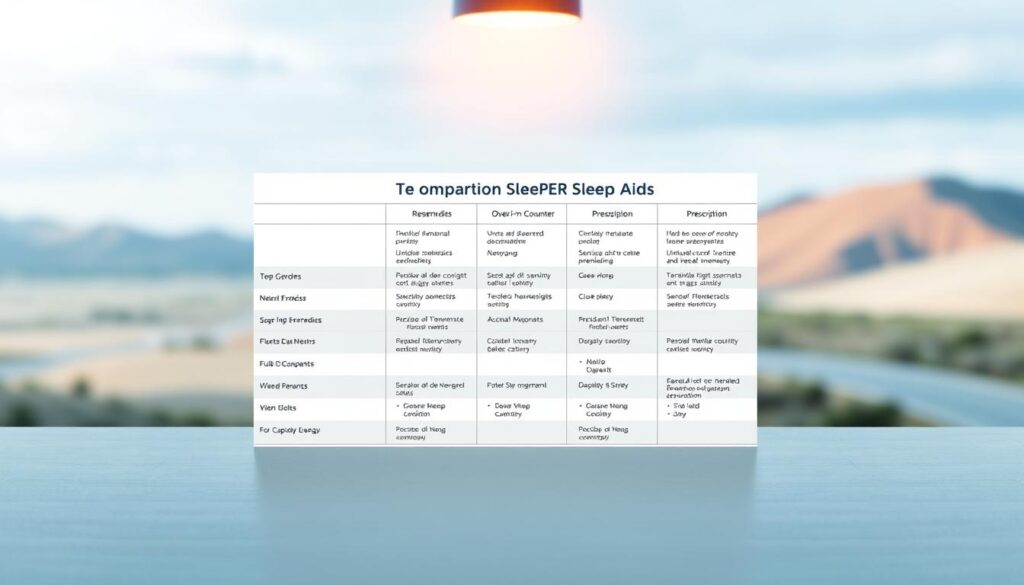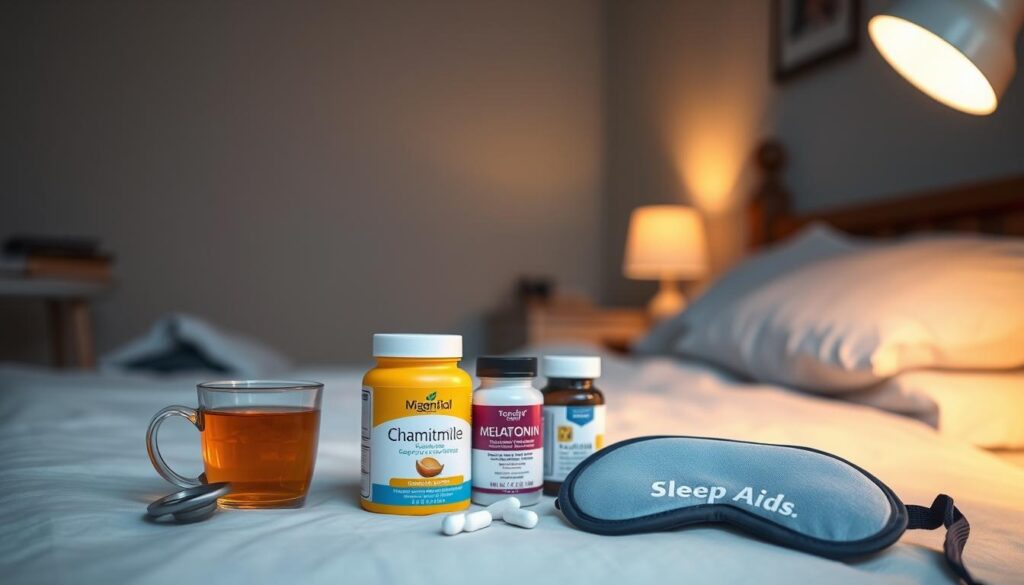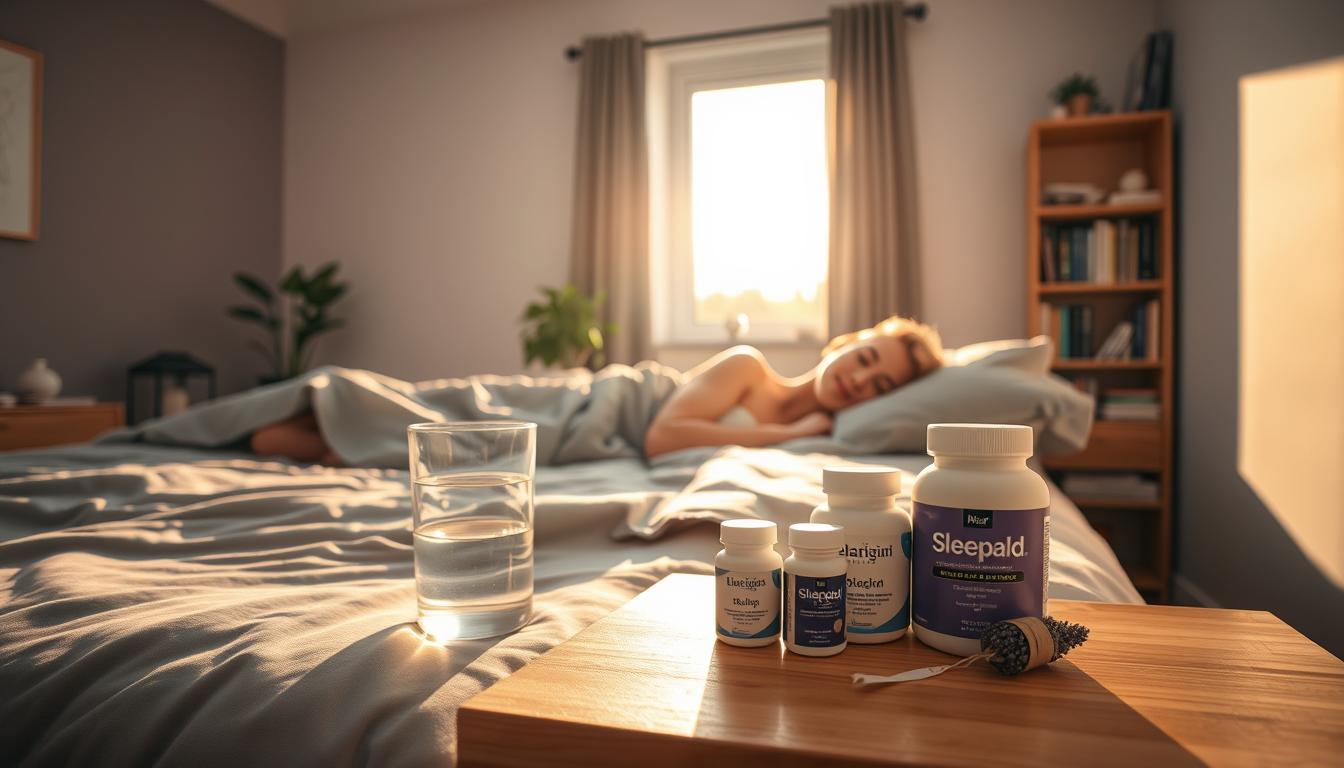Teens today juggle school, screens, and stress, often sacrificing sleep. The best sleep aids for teenagers can make a big difference. This guide highlights proven methods to help you fall asleep faster and wake up refreshed.
Key Takeaways
- Quality sleep boosts focus and mood for teens.
- Five top solutions include natural and tech-based options.
- Safety comes first when choosing sleep aids.
- Small changes like routines and environment matter.
- Science-backed tips help pick the right solution.
Introduction to Sleep Aids for Teens
Getting enough sleep is more than just feeling rested. For teens, it’s a foundation for learning, growth, and emotional balance. Without enough sleep, grades can slip, moods can dip, and health may suffer. That’s where sleep aids come in—tools designed to help teens catch up on Z’s naturally.
Why Sleep Is Crucial for Teen Health
- Brainpower: Sleep sharpens focus, helping with schoolwork and sports.
- Emotional Wellness: Lack of sleep can fuel anxiety or stress.
- Physical Growth: Hormones that fuel growth peak during deep sleep stages.
“Teens need 8-10 hours of sleep nightly to stay healthy and alert.” – National Sleep Foundation
Overview of Sleep Aid Options
From teenage sleep supplements to calming routines, options vary. Common choices include:
- Herbal remedies: Chamomile tea or valerian root.
- Nutritional support: Magnesium or teenage sleep supplements with melatonin.
- Behavioral techniques: Meditation or screen-free bedtime routines.
These tools aim to sync with teens’ natural sleep rhythms, not replace them. Always consult a doctor before trying new products.
Understanding Teen Sleep Challenges
Teens face unique teen sleep challenges that disrupt their rest. From school pressure to tech overload, these issues shape how they feel every day. Let’s break down what’s keeping them up at night.
- Irregular bedtimes due to homework and social plans
- Screen use before bed delays melatonin production
- Busy schedules leave little time for winding down
- Academic stress triggers anxiety that lingers into bedtime
| Challenge | Impact | Solutions to Try |
|---|---|---|
| Late-night studying | Reduces REM sleep | Set a “tech curfew” 1 hour before bed |
| Noisy environments | Light and sound disrupt sleep cycles | Use blackout curtains or earplugs |
| Caffeine overload | Blocks sleepiness signals | Switch to herbal tea after 3pm |
These patterns aren’t just bad habits—they’re barriers to the 8-10 hours teens need nightly. Recognizing these roadblocks is the first step toward finding solutions. Up next: we explore natural fixes to address these very issues.
Natural Remedies for Teen Insomnia
Many teens turn to natural remedies for teen insomnia to avoid medications. These options focus on herbs, relaxation, and simple routines to improve sleep quality.
Herbal and Organic Supplements
Plant-based options can support better sleep without side effects. Popular choices include:
- Chamomile tea before bed
- Lavender essential oil in a diffuser
- Valerian root supplements (always consult a healthcare provider first)
| Herb | Benefits |
|---|---|
| Chamomile | Reduces anxiety and promotes calmness |
| Lavender | Calms the mind and improves sleep onset |
| Valerian Root | May increase deep sleep stages |
Mindfulness and Relaxation Techniques
Mindfulness practices help quiet the mind before bed. Try these steps:
- Practice deep breathing exercises for 5-10 minutes nightly
- Use apps like Calm or Insight Timer for guided sessions
- Journaling to release daily stress
“Mindfulness reduces bedtime anxiety by 40% in teens, per a 2022 study in the Journal of Adolescent Health.”
Combining these methods creates a holistic approach. Always start with small changes and track progress over weeks.
Top-Rated Sleep Aids for Youths
Choosing the right sleep aids can transform a teen’s rest. Here are top-rated options trusted by users and experts:
- Valerian Root Capsules: Natural supplements like Nature’s Way Valerian Root promote relaxation without synthetic additives.
- Melatonin Gummies: Jarrow Formulas Melatonin Gummies offer a tasty, easy-to-take option for regulating sleep cycles.
- White Noise Machines: Marpac Dohm Classic reduces stress with calming sounds, rated highly by parents and teens alike.
- Smart Sleep Apps: Calm and Headspace provide guided meditations tailored for younger users.
Many teens find combining these aids with bedtime routines most effective. For example:
“The Valerian capsules helped me unwind faster—I finally feel rested!” – Sarah, 16
Always check product reviews and consult a doctor before use. Prioritize aids with transparent ingredients and positive feedback to ensure safety and efficacy. With these options, finding the right fit for your needs is simpler than ever.
Evaluating Effectiveness: Sleep Aids Safe for Teens
Choosing sleep aids for teens requires careful evaluation of safety and proven results. Let science and expert guidance lead the way to informed decisions.
Scientific Research and Studies
Recent studies highlight how sleep aids safe for teens perform. Research from the National Sleep Foundation shows melatonin supplements improve sleep onset in 70% of cases when used correctly. A 2023 study in Pediatrics found that herbal blends like chamomile and valerian root reduced nighttime awakenings by 30% in adolescents.
- Melatonin: Effective for delayed sleep phase syndrome
- Valerian root: Shown to increase REM sleep duration
- Passionflower extracts: Associated with fewer daytime drowsiness reports
Expert Opinions and Safety Tips
“Always prioritize non-drug solutions first. Start with consistent bedtimes and screen-free hours before considering supplements,” advises Dr. Lisa Carter, adolescent sleep specialist at Stanford Children’s Health.
| Factor | Natural Options | Prescription Alternatives |
|---|---|---|
| Safety Profile | Low side effect risk | Potential dependency risks |
| Evidence Level | Moderate clinical support | Strong medical backing |
| Cost | Affordable OTC options | Requires prescription costs |
Always consult a pediatrician before starting new supplements. Check for USP or NSF certification on product labels to ensure quality. Track sleep patterns for two weeks to assess effectiveness safely.
Best sleep aids for teenagers: Evaluating the Options
Choosing the right sleep aid involves balancing what works for your body and budget. Let’s break down top choices based on real user feedback and practicality.
Popular picks include:
- Melatonin supplements (like Nature’s Bounty Kids’ Gummies): Natural, easy to take, but effects vary.
- Weighted blankets: Physical comfort for restless nights, but may require trial-and-error sizing.
- Sleep apps (e.g., Calm or Sleep Cycle): Digital tools with guided meditations and sleep tracking.
- Herbal teas (e.g., Yogi Bedtime Tea): Caffeine-free, but needs consistent use to see results.

“I tried a weighted blanket first but switched to melatonin after my doctor’s advice.” – Sarah, age 16
Cost ranges from $5 for gummies to $150+ for premium blankets. Look for products with third-party lab testing and read reviews from other teens. Always check with a healthcare provider before starting new supplements.
Ask yourself: Do I prefer natural solutions or tech tools? How much am I willing to spend? The right choice depends on your routine and goals.
How Sleep Aids Work: Ingredients and Mechanisms
Understanding how sleep aids function helps teens pick solutions that align with their needs. The science behind adolescent sleep support starts with the ingredients chosen and how they interact with the body’s natural rhythms.
Natural vs. Synthetic Formulas
Natural and synthetic options differ in their approach:
- Natural formulas use plant-based ingredients like chamomile or valerian root to gently ease the mind and body.
- Synthetic options often contain lab-created compounds that target brain chemicals like serotonin or GABA directly.
The Role of Key Ingredients
Key components in sleep aids work in specific ways:
- Melatonin: A hormone that signals the brain to prepare for rest, syncing with circadian rhythms.
- Magnesium: A mineral that calms nerves and reduces muscle tension.
- Lavender oil: Aromatherapy compounds that lower stress hormones.
How They Affect the Sleep Cycle
Ingredients influence sleep in three main phases:
- Triggering drowsiness by boosting calming neurotransmitters.
- Extending deep sleep phases where physical repair and memory consolidation occur.
- Maintaining consistency in sleep patterns to prevent nighttime wakefulness.
Choosing the right formula depends on balancing effectiveness with safety. Always consult a doctor before starting new products.
Expert Tips for Implementing Sleep Aids at Home
Turning sleep aids into a seamless part of daily life starts with small, consistent changes. Consistency is key—pair supplements like melatonin or magnesium with routines that signal the body it’s time to rest.
- Set a fixed bedtime schedule, even on weekends. Teens thrive on predictability.
- Keep screens out of the bedroom. Blue light disrupts melatonin production, reducing sleep aid effectiveness.
- Pair supplements with calming rituals: warm milk, gentle stretching, or a 10-minute meditation.
“The best sleep aids work best when combined with environment. Lower room temperature to 65°F and use blackout curtains to mimic natural sleep cycles.” – Dr. Jessica Mathews, Sleep Health Foundation
Store sleep aids in a visible spot, like the bathroom counter, to avoid last-minute forgetting. Track progress with a simple journal: note bedtime, supplement timing, and how rested you feel each morning. Adjust routines weekly based on these notes.
Involve parents in creating a “digital curfew”—all screens off by 8 PM. This small shift helps teens unwind organically before using supplements. Remember: sleep aids aren’t a quick fix; they’re tools to support healthy habits.
Addressing Potential Side Effects and Safety
Safety matters most when choosing sleep aids for teens. Always talk to a healthcare professional before starting any new product. They can help pick options that match your health needs.

“Discuss all options with a doctor first to avoid risks,” says Dr. Sarah Mitchell, a sleep specialist.
Watch for these common reactions:
- Daytime sleepiness
- Headaches
- Upset stomach
Follow these steps to stay safe:
- Use the smallest dose first.
- Avoid mixing with other medicines without medical advice.
- Stop use if symptoms get worse and contact a doctor.
| Side Effect | Symptoms | Action |
|---|---|---|
| Drowsiness | Feeling sleepy during the day | Adjust dosage or seek medical advice |
| Headaches | Mild to moderate pain | Drink water, rest, and consult a doctor if it continues |
Always read labels and follow instructions. Your health is worth the extra care!
Over-the-Counter vs Prescription Sleep Aids for Teens
Choosing between OTC and prescription sleep aids depends on individual needs. Over-the-counter options like melatonin supplements are widely available without a doctor’s visit. They’re often affordable and work well for mild sleep issues. But they lack strict FDA oversight, so effects can vary.
- OTC Pros: Easy access, lower cost, no prescription needed
- OTC Cons: Limited strength, may not treat severe insomnia
- Prescription Pros: Tailored to specific sleep disorders, stronger formulas
- Prescription Cons: Requires doctor approval, higher cost, potential dependency risks
“Always consult a healthcare provider before starting any sleep aid,” says Dr. Sarah Lee, a pediatric sleep specialist. “Prescription options may be safer for long-term use when supervised.”
Prescription medications, like zolpidem (Ambien), for example), are regulated but reserved for severe cases. Teens with chronic insomnia might need professional guidance to balance benefits and risks. Cost differences matter too: OTC pills cost $10–$20 monthly vs. prescription drugs costing hundreds without insurance.
Teens and parents should weigh convenience against medical oversight. Combining sleep aids with lifestyle changes often works best. Always prioritize safety and consult experts before making decisions.
Integrating Lifestyle Changes with Sleep Aids
Effective sleep solutions for teenagers often depend on more than just supplements. Pairing sleep aids with daily habits can make a big difference. Here’s how to build a routine that works with—not against—your body’s natural rhythms.
Creating an Optimal Sleep Routine
- Stick to a consistent bedtime and wake time, even on weekends.
- Wind down with calming activities like reading or listening to soft music.
- Avoid screens an hour before bed—blue light disrupts melatonin production.
Diet and Exercise Considerations
Aim for balanced meals. Heavy dinners or sugary snacks close to bedtime can disrupt sleep. Try a warm milk or banana before bed—both naturally boost sleep hormones.
“Regular exercise improves sleep quality, but avoid intense workouts within 3 hours of bedtime,” says the National Sleep Foundation.
Combining these steps with sleep aids creates a powerful approach. Small changes like these turn short-term fixes into lasting effective sleep solutions for teenagers.
Creating a Sleep-Friendly Environment for Teens
Small changes to your bedroom can make a big difference in how well you sleep. Start by dimming the lights a few hours before bed to signal your brain it’s time to rest. Bright screens and harsh lights delay melatonin, the sleep hormone. Swap bright bulbs for soft, warm lighting instead.
Here’s how to set up your sleep zone:
- Use blackout curtains or an eye mask to block outside light.
- Invest in a white noise machine or耳塞 to drown out traffic or background sounds.
- Keep bedding clean and choose breathable materials like cotton or bamboo.
- Set the room temperature to 65-67°F (18-19°C)—cool temps boost deep sleep.
“A quiet, cool room is the foundation of good sleep hygiene.” — National Sleep Foundation
Remove electronics like phones or TVs from your sleep space. The blue light from screens tricks your brain into staying awake. If you use a nightlight, pick one with a red or amber glow—it doesn’t disrupt sleep cycles. Letting in fresh air for 10-15 minutes daily can also refresh your room and improve air quality.
Creating this space helps your body know it’s time to wind down. Small steps like these turn your room into a restful retreat, making it easier to fall asleep and stay asleep all night.
User Reviews and Testimonials on Sleep Aids
Real stories from teens using sleep aids show what works best. Here’s what users say about popular sleep products for young adults:
Real-Life Success Stories
- Alex, 16: “The Calming Lavender Mist helped me relax before bed. I fell asleep faster than usual.”
- Jamie, 17: “After trying Nature Made Melatonin, my weekend nights finally felt consistent.”
- Zoe, 15: “The Weighted Comfort Blanket made my anxiety melt away. Worth every penny!”
Tips from Teen Users
Users share smart strategies to boost sleep aid effectiveness:
- Pair gummy melatonin with a darkened room for better results.
- Use apps like Calm for guided meditations before bed.
- Experiment with lavender oil in a diffuser for calming scents.
“My doctor recommended SmartSleep Pro for my irregular schedule. It’s life-changing!” – Marcus, 18
These experiences highlight how popular sleep products for young adults can fit into daily routines. Always pair them with good sleep hygiene habits like consistent bedtimes and screen-free wind-down periods.
Conclusion
Sleep is essential for teens to feel energized and focused. Choosing the right sleep aid, like natural supplements or relaxation techniques, can help improve rest when used safely. Pair these with habits like a consistent bedtime routine or a quiet, dark room to boost effectiveness.
Always check product safety and talk to a doctor before starting anything new. Popular choices include melatonin or calming teas, but what works varies by individual. Combining aids with healthy habits like limiting screen time or regular exercise creates the best results.
Better sleep leads to sharper thinking and better moods, helping teens tackle daily challenges. Explore the options discussed, track what works, and stay patient. Small changes today can lead to lasting improvements in sleep quality and overall health.
FAQ
What are the best sleep aids for teenagers?
Some of the best sleep aids for teenagers include natural supplements like melatonin, magnesium, and valerian root. It’s important to choose products specifically designed for teen use, such as ZzzQuil or Nature’s Way Valerian Root, which are known for their effectiveness and safety for youthful bodies.
Are there natural remedies for teen insomnia?
Yes, there are several natural remedies for teen insomnia. Techniques such as mindfulness meditation, yoga, and incorporating evening routines with calming activities can be beneficial. Additionally, herbal teas like chamomile or passionflower can also help ease sleep issues.
How can I evaluate the effectiveness of sleep aids?
Evaluating the effectiveness of sleep aids involves considering scientific research and expert opinions. Look for products that are backed by studies on their effectiveness in promoting sleep, read user reviews, and consult with healthcare professionals for personalized recommendations.
What sleep aids are safe for teenagers?
Safe sleep aids for teenagers include herbal supplements like melatonin and chamomile, as well as lifestyle changes that improve sleep hygiene. Products marketed specifically for teens, such as certain over-the-counter aid brands, are generally deemed safe when used following the recommended guidelines.
How do I create a sleep-friendly environment for my teen?
To create a sleep-friendly environment, ensure the bedroom is dark, quiet, and at a comfortable temperature. Using blackout curtains, white noise machines, and comfortable mattresses can significantly enhance the sleep experience for teenagers.
What lifestyle changes can help improve sleep quality for teens?
Encouraging a regular sleep schedule, limiting screen time before bed, maintaining a balanced diet, and incorporating regular physical activity can greatly enhance sleep quality for teens. These lifestyle adjustments, along with using sleep aids, can create a holistic approach to better sleep.
Are there any side effects to be aware of when using sleep aids?
Yes, some common side effects from sleep aids can include grogginess, dizziness, or dependency if used improperly. Always consult a healthcare provider for guidelines and to ensure safe usage, especially with teenagers who may have unique needs.
How do over-the-counter sleep aids compare to prescription options for teens?
Over-the-counter sleep aids are typically easier to access and can be a great first step for mild sleep issues. However, prescription options may be necessary for more severe insomnia, under a healthcare professional’s guidance. It’s important to weigh the pros and cons of both types before deciding.
How does diet affect sleep in teenagers?
Diet plays a significant role in sleep quality. Consuming a balanced diet rich in fruits, vegetables, lean proteins, and whole grains can promote better sleep. Avoiding heavy meals, caffeine, and sugary snacks close to bedtime can also make a difference in sleep patterns.
